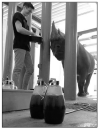Practical Management of Iron Overload Disorder (IOD) in Black Rhinoceros (BR; Diceros bicornis)
- PMID: 33138144
- PMCID: PMC7692874
- DOI: 10.3390/ani10111991
Practical Management of Iron Overload Disorder (IOD) in Black Rhinoceros (BR; Diceros bicornis)
Abstract
Critically endangered black rhinoceros (BR) under human care are predisposed to non-hemochromatosis Iron Overload Disorder (IOD). Over the last 30 years, BR have been documented with diseases that have either been induced by or exacerbated by IOD, prompting significant efforts to investigate and address this disorder. IOD is a multi-factorial chronic disease process requiring an evidence-based and integrative long-term approach. While research continues to elucidate the complexities of iron absorption, metabolism, and dysregulation in this species, preventive treatments are recommended and explained herein. The aim of this report is to highlight the accumulated evidence in nutrition, clinical medicine, and behavioral husbandry supporting the successful management of this disorder to ensure optimal animal health, welfare, and longevity for a sustainable black rhinoceros population.
Keywords: chelation; ferritin; hemochromatosis; hemosiderosis; oxidative stress; phlebotomy; transferrin saturation.
Conflict of interest statement
The authors declare no conflict of interest.
Figures












References
-
- IUCN: International Union for Conservation of Nature. [(accessed on 28 September 2020)]; Available online: https://www.iucn.org/sites/dev/files/import/downloads/black_rhino_v3.pdf.
-
- Ferrie G.M. AZA Regional Studbook Eastern Black Rhinoceros (Diceros bicornis Michaeli) AZA; Bay Lake, FL, USA: 2020.
-
- Clauss M., Dierenfeld E., Goff J., Klasing K., Koutsos L., Lavin S.R., Livingston S., Nielson B., Schlegel M., Sullivan K., et al. Iod in rhinos—Nutrition group report: Report from the nutrition working group of the international workshop on iron overload disorder in browsing rhinoceros (February 2011) J. Zoo Wildl. Med. 2012;43 doi: 10.1638/1042-7260-43.3s.S108. - DOI - PubMed
Publication types
LinkOut - more resources
Full Text Sources

